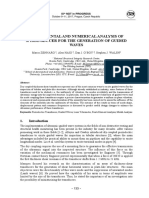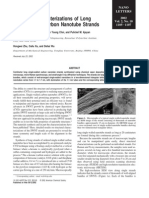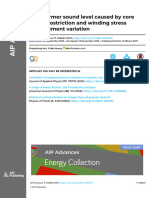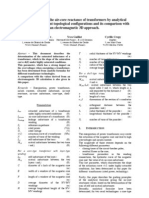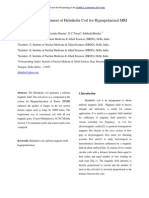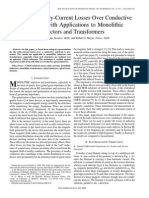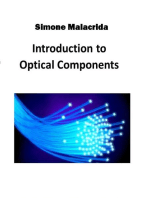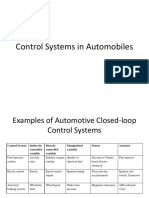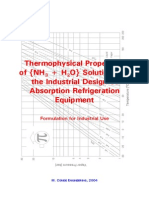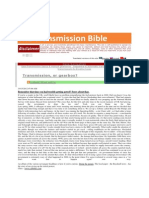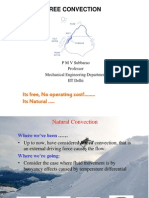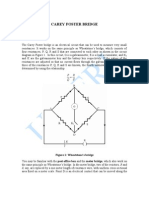Propagation of Highly Nonlinear Solitary Waves in A Curved Granular Chain
Propagation of Highly Nonlinear Solitary Waves in A Curved Granular Chain
Uploaded by
zeeshanahmad111Copyright:
Available Formats
Propagation of Highly Nonlinear Solitary Waves in A Curved Granular Chain
Propagation of Highly Nonlinear Solitary Waves in A Curved Granular Chain
Uploaded by
zeeshanahmad111Original Description:
Original Title
Copyright
Available Formats
Share this document
Did you find this document useful?
Is this content inappropriate?
Copyright:
Available Formats
Propagation of Highly Nonlinear Solitary Waves in A Curved Granular Chain
Propagation of Highly Nonlinear Solitary Waves in A Curved Granular Chain
Uploaded by
zeeshanahmad111Copyright:
Available Formats
Granular Matter DOI 10.
1007/s10035-013-0414-z
ORIGINAL PAPER
Propagation of highly nonlinear solitary waves in a curved granular chain
Luyao Cai Jinkyu Yang Piervincenzo Rizzo Xianglei Ni Chiara Daraio
Received: 8 August 2012 Springer-Verlag Berlin Heidelberg 2013
Abstract We assemble granular chains composed of spheres of uniform diameter in different curved congurations. We study the properties of highly nonlinear solitary waves traveling in the curved channels as a function of the curve angle and of the radius of curvature, using experiments and numerical simulations. We observe that solitary waves propagate robustly even under drastic deection, such as 90 and 180 turns. When the solitary waves encounter a sharp turn with a radius of curvature as small as one spherical particles diameter, we report the formation of secondary solitary waves resulting from the interaction with the guiding rail. We compare experimental results with numerical simulations based on a discrete element model that accounts for nonlinear and dissipative interactions between particles. This study demonstrates that granular chains are efcient wave-guides, even in complex geometrical congurations. Moreover, the ndings in this study suggest that solitary waves could be used as novel information and/or energy carriers.
L. Cai P. Rizzo (B) X. Ni Laboratory for Nondestructive Evaluation and Structural Health Monitoring Studies, Department of Civil and Environmental Engineering, University of Pittsburgh, 729 Benedum Hall, 3700 OHara St., Pittsburgh, PA 15261, USA e-mail: pir3@pitt.edu J. Yang Department of Mechanical Engineering, University of South Carolina, 300 Main Street, Room A220, Columbia, SC 29208, USA C. Daraio Engineering and Applied Science, California Institute of Technology, 1200 E California Boulevard, MC 105-50, Pasadena, CA 91125, USA C. Daraio Department of Mechanical and Process Engineering, ETH Zrich, Tannenstrasse 3, 8092 Zrich, Switzerland
Keywords Highly nonlinear solitary waves Granular systems Wave guiding
1 Introduction Over the last decade, the study of highly nonlinear solitary waves (HNSWs) has drawn increasing attention at the fundamental level and for engineering applications [130]. HNSWs can be generated in a straight chain of spherical particles, where dispersive and nonlinear effects, due to the discreteness of the system and the Hertzian contact among spheres, are balanced. We refer to such ordered granular chains as one-dimensional (1D) granular crystals. Previous studies suggested HNSWs for different engineering applications, for example, as impurity detectors in granular systems [3,7], nozzle-free ink-jet printer [5], acoustic lenses [20], impact mitigation [8,13,18], and nondestructive testing [17,2630]. In these applications, the granular crystals serve as a new type of waveguide and/or information carrier by transmitting, redirecting, or blocking solitary waves in a controllable and efcient manner. Previous studies mainly focused on the propagation of solitary waves in a straight 1-D array of particles. The physical mechanism of solitary waves transmission in deected or curved chains is largely unexplored. Daraio et al. [19] have reported exible redirecting and splitting of solitary waves in a straight granular chain that diverges into two branches using Y-shaped guides. Yang et al. [25] studied the propagation of solitary waves in a curved granular crystal enclosed by exible guides with the focus on the coupling between the granules and the deformable media for impact mitigation. However, no studies systematically characterized the effects of chain deection and radius of curvature on the solitary waves transmission and reection.
123
L. Cai et al.
In this study, we investigated experimentally and numerically how the characteristics of solitary waves are affected by the geometry of a bent granular chain. Particularly, we evaluated the effect of the radius of curvature and the deection angle between two straight granular segments on the transmission efciency of the waves. For the experimental study, we connected two straight granular segments supported by modular guiding rails that could be congured in different curvatures and deection angles. We measured the waves characteristics using sensors located before and after the curved section of the chain. The results were compared with numerical simulations based on a discrete element model (DEM) that accounted for nonlinear and dissipative effects in the particles interactions. We found that solitary waves can be efciently transmitted in a curved chain through the point contact between grains, maintaining their compact shape. Particularly, even under drastic bends, such as 90 and 180 turns, the solitary waves preserved a signicant portion of the momentum and energy. This suggests the use of granular chains as exible wave-guides for momentum and energy transmission of elastic waves. If the granular chains exhibit sharp turns, with radii of curvatures as small as a one spherical particles diameter, we observed that the solitary waves are partially transmitted across the bends and secondary reected solitary pulses are formed. The paper is organized as follows: In Sect. 2, we describe the experimental setup. In Sect. 3, we introduce the DEM used to simulate the propagation of solitary waves in the curved chains. The experimental and numerical results are discussed in Sect. 4. We conclude the paper in Sect. 5 with a summary of ndings and their implications.
2 Experimental setup To evaluate the effect of the granular chains geometry on the propagation of HNSWs, we assembled modular guide rails in a variety of congurations. Each conguration was built by connecting two straight channels with curved rails, which had different radii of curvature and bent angles. Figure 1a displays one of the congurations used to evaluate the effect of the angle at a constant radius of curvature Rc . The front and rear straight chains were composed of N1 = 18 and N3 = 15 spheres, respectively, conned by structural berglass square tubes (having sides 25.4 25.4 mm, and wall thickness 3.175 mm, McMasterCarr product number 8548K21), with the rst particle being the striker bead. The curved channels were made of Delrin acetal resin to reduce friction. The elastic modulus and Poissons ratio of the Delrin guide were E G = 3.2 GPa and vG = 0.35, respectively. The particles were stainless steel bearing-quality balls (type 302, McMasterCarr) with a diameter D = 19.05 mm, mass m = 29 g, elastic modulus E = 200 GPa, and Poissons ratio
v = 0.28. The number of particles ( N2 ) in the curved section was varied depending on the bent angle and the curvature. We conducted two sets of experiments. In the rst set, we investigated the effect of the deection angle on the amplitude of the propagating solitary waves. We considered nine different angles ( = [0 , 30 , 45 , 60 , 90 , 120 , 135 , 150 , 180 ]) keeping the radius of curvature constant and equal to Rc = 76.20 mm. The photo of the setup is shown in Fig. 1a with the different elbows presented in the inset. These angles tested correspond to N2 = [1, 3, 3, 5, 7, 9, 9, 11, 13] included in the curved rail. To ensure the contact between adjacent particles, the whole system leaned against a reaction wall mounted at the end of the third segment. In the second set of experiments, we systematically varied Rc in order to evaluate the effect of the chains curvature on the solitary waves properties. We devised six different segments that deected the direction of the wave propagation by 90 . We considered Rc equal to 19.05 [1, 2, 3, 4, 5, 6] mm. Figure 1b displays the setup and the different bent sections used. The corresponding number N2 of beads along the curve was equal to N2 = [1, 3, 5, 7, 7, 9]. The bent section with the largest radius of curvature ( Rc = 6d ) hosted nine spheres, while the smallest ( Rc = d ) contained only a single particle. For both sets of experiments, the solitary waves were excited by the transducer shown in Fig. 2a. It consisted of an electromagnet made of a magnetic wire coil (AWG24) of about 1,350 turns wrapped around a 13 mm diameter and 33 mm long iron core. The electromagnet lifted a striker particle (19.05 mm-diameter) along the plastic slider. A DC power supply (BK precision Model 1672) was used to provide electrical current to the coil. The drop height of the striker was 4.7 mm, resulting in the striker velocity v 0.30 m/s. To prevent the movement of the rst particle of the chain toward the slider, a small plastic sleeve was glued to the bottom of the electromagnet. As the electrical resistance of the coil depends on the coil temperature, the power supply was used in current control mode to keep the current constant. The electromagnet was coupled to a switch circuit, driven by a National InstrumentsPXI running in LabVIEW. With the switch closed, the electrical current passed through the coil allowing the motion of the striker. A LabVIEW front panel was designed to operate the actuator automatically. Five sensor particles were assembled and used to measure the propagation of the HNSWs generated by the mechanical impact of the striker. Each sensor bead contained a piezoelectric ceramic disc (circular plate with 0.3 mm thickness and 19.05 mm diameter) with silver electrodes and microminiature wiring (Fig. 2b). The assembling and calibration procedures of the instrumented particles were similar to those described in [12]. To quantify the effect of the geometry on the properties of the solitary waves, two sensor beads, namely S1 and S2 , were positioned along the rst segment at the 11th and 16th positions (see Fig. 1). These sensors measured the
123
Propagation of highly nonlinear solitary waves Fig. 1 Digital images of the experimental setups. a Setup to study the effect of variable deection angles at a given radius of curvature Rc . The setup presented in the photo has = 120 and a radius of curvature Rc = 4d (bead diameter d = 19.05 mm). The inset shows an assortment of eight different curved guide rails with = [30 , 45 , 60 , 90 , 120 , 135 , 150 , 180 ] and Rc = 4d . b Setup to study the effect of different radii of curvature at a given deection angle. The setup presented in the photo has = 90 and Rc = d (bead diameter d = 19.05 mm). The inset shows an assortment of six different guide rails with a right angle and Rc = [1, 2, 3, 4, 5, 6] d
(a)
= 30
45
60
90
120
135
Rc
150
180
(b)
Rc = 6d
5d
4d
3d
2d
Fig. 2 a Photo of the electromagnet employed to lift the striker particle along a plastic slider. b Schematic of a PZT-embedded sensor particle used for capturing the propagation of solitary waves
(a)
(b)
Kapton tape PZT
Wire Cap
123
L. Cai et al. Fig. 3 Schematic diagram of the 2D DEM. is the deection angle and Rc the radius of curvature. The number of spherical particles in the curved section ( N2 ) is determined by and Rc and it is summarized in Table 1. The inset shows the approximation of spherical particles into point-masses connected by nonlinear springs and dampers
t
n
( xi 1 , yi 1 )
f n ,( i 1,i )
( xi , yi )
f n ,(i ,i +1)
( xi +1 , yi +1 )
f t ,i
N1
Rc N2 N3
characteristics of the solitary waves before they reach the elbow. Two sensors, S3 and S4 , were positioned along the 2nd and 7th positions of the straight segment after the bend in order to capture the waveforms and to measure the waves speed after the elbow. The sensor particles were connected to an oscilloscope and the signals were digitized at 10 MHz sampling rate. To assess repeatability, 50 measurements were taken for each case and processed statistically in Matlab.
of-mass alignment. The rst term represents the nonlinear Hertzian contact force between two identical spherical bodies. According to the Hertzian contact law, the contact coef cient An can be expressed as E D /[3(1 v 2 )] with E , v , and D denoting elastic modulus, Poissons ratio, and diameter of the spherical particles, respectively [31]. The dissipative effect caused by damping factors, such as friction and viscoelasticity, is taken into account by the second term, which is based on the damping model developed by Tsuji et al. [32]. In this model, the damping coefcient n is given by: n = n (m An /2)1/2 n .
1/4
3 Numerical approach We simulated the propagation of solitary waves in granular crystals using a DEM [1,25]. The DEM approach approximated the granular chain as an assembly of discrete lumped masses connected by interfacial springs, similar to a molecular dynamics approach. In this study, we accounted for the nonlinear and dissipative nature of the particles axial interactions to predict the attenuation of the traveling waves. Tangential interactions were neglected, assuming that the rotational motion of the particles was very small. We will later discuss the validity of this assumption based on the numerical results. Figure 3 illustrates a schematic diagram of the DEM model, including the deection angle and the radius of curvature Rc . The contact force f n between two neighboring particles can be described as: f n = A n n
3/2
(2)
n n , + n
(1)
where n is the approach under the compressive interactions is the unit vector in the direction of their centerand n
Here, m is the particle mass and n is the constant that can be analytically deduced from the coefcient of restitution (e) between two colliding identical particles [32], which is dened as the ratio of the rebounding particle velocity to the incident one under collision. However, the dynamics of the granular chain in this study involves multiple particle interactions [1]. As a consequence, the analytical value n obtained for a two-particle collision does not accurately account for the chains dissipation. We empirically determined the axial dissipation coefcient n = 0.02 to match experimental results. This value falls in the range an = 0.010.05 predicted analytically by the Tsujis model [32]. According to the Tsujis analytical relationship between e and n , this corresponds to e 0.95 and matches reasonably well the experimentally reported restitution coefcients of stainless steel spheres [33,34]. In this study, the elastic contact relationship between the granules and the guiding walls was built based on the Hertzian contact law similar to the axial relationship [31].
123
Propagation of highly nonlinear solitary waves
Normalized force
As shown in Fig. 3, transverse forces arise when the granules are conned in a curved section. The net force by the misaligned axial compressions is balanced with the normal force by the wall. The transverse contact force f t against the guide can be expressed as: f t = A t t
3/2
2.5 2 1.5
As3/As1
Experiment Simulation
As4/As1
S4 S3 S2 S1
0.5 1 1.5 2 Time [ms] 2.5 3
t t, + t
(3)
where t is the spheres displacement in the transverse direction t (Fig. 3). Note that the direction of the transversal contact force can be either inward or outward, depending on which rail the sphere forms contact with. In Eq. (3), the contact coefcient is: 2 2D , (4) At = 2 1G 1 2 3 E + EG where E G is the walls elastic modulus and vG the walls Poissons ratio [31]. The damping coefcient t takes a modied form compared to (2) as [25,32]: t = t (m At )1/2 t .
1/4
1
As2/As1
0.5 0
(5)
Fig. 4 Temporal force proles of solitary waves propagating along a straight granular chain ( = 0 ). Each force prole recorded from one of four sensors ( S1 , S2 , S3 , and S4 ) was normalized with respect to the maximum force magnitude of S1 measurement (denoted as As1 ), and is shifted vertically by 0.5 to ease visualization. Experimental and numerical results are represented by solid and dotted curves, respectively
The damping parameter t = 0.999 was selected empirically to match the experimental results, as presented in Sect. 4. Note that this damping parameter in the transverse direction is much larger than n that we obtained for the axial damping. This is because the interactions of stainless-steel particles with the Delrin guide are more dissipative compared to the particle-to-particle interactions due to the viscoelastic effect of the polymeric wall. Based on the contact forces exerted on the spheres, we built the equation of motion for the i th particle: f n ,(i 1,i ) + f n ,(i ,i +1) + f t ,i , (6) m where ai is the acceleration (see Fig. 3 for the notations of force components). We solve this differential equation to calculate each particles displacements using a RungeKutta-4 integration scheme in Matlab. ai =
4 Results and discussion 4.1 Effect of the deection angle Figure 4 shows the temporal force prole measured by the four sensor particles, normalized with respect to the force magnitude (AS1 ) measured by the rst sensor S1 , when q = 0 . The experimental results (presented with solid lines) are superimposed to the numerical results (presented with dotted lines). The proles are shifted vertically to ease visualization. We observe the formation of a single compactly supported pulse. We nd that the amount of attenuation of this incident solitary wave is not signicant, as suggested by the
ratios of the peak amplitude measured by the different sensors with respect to that measured by sensor S1 ( As 2 / As 1 = 0.984, As 3 / As 1 = 0.964, and As 4 / As 1 = 0.975). The solitary wave reects from the hard wall positioned at the end of the rear segment, and it is again measured by the sensors as shown by the second pulse in each prole. The reected pulse is followed by a smaller pulse which denotes secondary solitary waves, probably generated during the interaction with the wall at the end of the chain. The forming mechanisms of such secondary solitary pulses will be briey discussed in Sect. 4.2, while the details can be found in [24]. We nd that the overall shape of the propagating pulses is identical throughout the chain, and the experimental and numerical results are in very good agreement. The noticeable attenuation of the reected solitary waves is due to losses at the end wall. The transmission of solitary waves through a 90 -curved chain is illustrated in Fig. 5, which refers to Rc = 6d , where d = 19.05 mm is the bead diameter. Compared to the straight chain, we clearly observe the attenuation of solitary waves in the signals measured from S3 and S4 after the curved section. The normalized peak amplitude of sensors S3 and S4 are As3 / As1 = 0.723 and As4 / As1 = 0.722, respectively. Thus, it is evident that the presence of the 90 elbow mostly contributes to the decrease of the amplitude of the traveling wave. This is due to the loss of force components to the guiding rail through the lateral contacts in the curved section. A small fraction of the force loss is due to the presence of ve more particles (when compared to the 0 case) between sensors S2 and S3 . Despite the reduction in the force ampli-
123
L. Cai et al.
As4/As1
Transmission ratio [ASn/AS1]
Experiment Simulation
1 0.9 0.8 0.7 0.6 0.5 0.4 0
AS2/AS1 - Exp. AS3/AS1 - Exp. AS4/AS1 - Exp. AS2/AS1 - Sim. AS3/AS1 - Sim. AS4/AS1 - Sim.
Normalized force
1.5
As3/As1
S4 S3 S2 S1
0.5 1 1.5 2 Time [ms] 2.5 3
1
As2/As1
0.5
50
100
[deg]
150
Fig. 5 Temporal force proles of solitary waves propagating along a curved granular chain with = 90 and Rc = 6 d . We nd that the amplitude of the solitary wave traveling after the curved section, measured by sensor beads S3 and S4 is attenuated noticeably. This is different from the conservative trend of solitary wave propagation in a straight chain as shown in Fig. 4
Fig. 6 Transmission ratios of solitary waves through curved segments as a function of the deection angles . The discrete points with error bars (95 % CI) represent the experimental values, while lines denote numerical results obtained from DEM
tude, we observe that the shape of the incident wave is preserved remarkably well after the bend, as shown in S3 and S4 signals around 1.0 and 1.2 ms-time. Moreover, there are negligible reections generated by the elbow. Thus, the granular chains can efciently transmit solitary waves without significant distortion even in a sharp turn such as 90 . The transmission ratio of the solitary waves before and after the bent section was quantied for all nine deection angles considered. Figure 6 shows the transmission ratio ASn /AS1 (n = 2, 3, 4) as a function of the angle . Each dot indicates the average value of the 50 measurements taken at each angle, and the vertical error bars denote a 95.5 % (2 ) condence interval (CI). The barely visible error bars demonstrate the repeatability of the testing. Figure 6 shows that the amplitude of the solitary waves linearly decreases with the increase of the deection angle. Notably, when the solitary wave is redirected by 90 , the transmission ratio is 0.65. At 180 -turn, 47 % of the solitary waves amplitude is transmitted to the rear straight segment. These experimental values are superimposed to the numerical results obtained using the DEM described in Sect. 3. We nd that the numerical and experimental results are in excellent agreement. Note that rotational mechanics of granules was not taken into account in the DEM model. This means that the primary mode of energy and momentum transmission in 1D granular chains is through axial contacts. Thus, the capability to transmit the wave along the chain is attributed to the axial point contact between granules, which leads to the formation of robust solitary waves. This is in contrast to random, dissipative granular architectures in which particles rotational dynamics cannot be neglected.
The velocities of the solitary pulse before and after the curved segment are reported in Fig. 7 as a function of the deection angle. Experimentally, we observe a linear decrease of the speed. At 180 , the speed of transmitted solitary wave is about 13 % lower than that of the straight chain. The general trend of the velocity curve is very similar to that of the transmission ratio in Fig. 6. This is due to the unique nature of nonlinear waves that exhibit strong dependence of wave speed on its amplitude. In the case of highly nonlinear solitary waves, the waves propagation speed, vs , is related to 1/6 the waves maximum amplitude, Fm , as vs Fm [1,16]. In Fig. 7, we notice some discrepancies between the experimental and numerical results, though their responses are qualitatively similar. Such discrepancies might be caused by the inaccurate simulation parameters, such as striker velocity and material properties, or by more complex dissipative effects in experiments than those accounted for in the numerical model. 4.2 Effect of the curvature As summarized in Table 1, we studied six different radii of curvature (Rc ) that deected the trajectory of the wave propagation direction by 90 . The numerical and experimental normalized force proles for the smallest Rc are presented in Fig. 8. The amplitude of the traveling pulse measured by sensor S2 is 99.2 % of the amplitude measured by the rst sensor, i.e. AS2 /AS1 = 0.992, and the wave maintains its robust, single-hump shape. However, we witness signicant attenuation of solitary waves after the bent section. The relative amplitudes of the solitary waves peaks were 0.390 and 0.384, respectively, when measured from S3 and S4 . This is a higher attenuation compared to the 90 -deection with a larger radius of curvature ( Rc = 6d ).
123
Propagation of highly nonlinear solitary waves
560 540
2
As4/As1
Experiment Simulation
1.5 Normalized force
Velocity [m/s] 520 500 480 460 440
S4
As3/As1
1
As2/As1
S3 S2
ASSWs1/As1
Before curvature - Exp. After curvature - Exp. Before curvature - Sim. After curvature - Sim.
0.5
S1
2.5 3
0
0 50 100 [deg] 150
0.5
Fig. 7 Velocities of solitary waves as a function of deection angles , measured before (solid ) and after (dashed ) deection. The discrete points with error bars (95 % CI) represent the experimental values, while lines denote numerical results obtained from DEM Table 1 Geometric properties of the curved granular chains investigated in this study Experiment Set 1: effect of the deection angle N1 N2 N3 q ( ) Rc (mm) 18 18 18 18 18 18 18 18 18 Set 2: effect of the radius of curvature 18 18 18 18 18 18 1 3 3 5 7 9 9 11 13 1 3 5 7 7 9 15 15 15 15 15 15 15 15 15 15 15 15 15 15 15 0 30 45 60 90 120 135 150 180 90 90 90 90 90 90 76.20 76.20 76.20 76.20 76.20 76.20 76.20 76.20 76.20 19.05 38.10 57.15 76.20 95.25 114.3
1.5 2 Time [ms]
Fig. 8 Temporal force proles of solitary waves propagating along a curved granular chain with = 90 and Rc = d . Compared to the results from a larger curvature (e.g., Rc = 6d in Fig. 5), we nd that the solitary waves are further attenuated after the deection. The presence of secondary solitary waves generated by the elbow is emphasized with dashed circles
Besides the reduction in the force amplitude, the small radius of curvature induces the formation of secondary solitary waves even before the reection from the wall, as indicated by the circles in Fig. 8. These secondary waves tail the incident pulse and are partially transmitted and partially reected at the elbow. According to previous studies, the mechanism of formation of secondary solitary waves can be explained by the complex dynamic interaction between the particles and their bounding media [10,24]. When a granule collides against a soft wall, its contact time tends to be signicantly longer, due to the low contact stiffness at
the wall interface. This causes the separation of the particle from the rest of the chain. Eventually, the rebounding particle against the wall collides with the chain, resulting in the partial reection of incoming solitary waves. At the same time, the transmitted solitary waves experience the disintegration into a group of primary and secondary solitary waves due to the multiple collisions among the granules. The details of such complex particle dynamics in relation to material properties are described in the reference [24]. In the bent chains tested in this study, the propagation of solitary waves is obstructed by the guiding structure. The momentum carried by the incident wave is split between the transmitted pulse and a secondary reected solitary pulse, and it is also partially dispersed to the guiding material. If the curvature is low (i.e. if the radius of curvature is high), the interaction between the spheres and the rail is not signicant, and no secondary pulses are formed (for example, when Rc = 6d ). We found experimentally that the mechanism of formation of secondary waves at the elbow is not only affected by the chain curvature, but also by the deection angle and the combination of spheres and rails material properties. According to the ndings in [24], we speculate that the softer the guiding rail is, the more likely is the secondary solitary waves formation. We numerically calculated the ratios of secondary solitary waves amplitude ( A SSW , s1 ) to those of the incident waves ( As 1 ) based on the S1 signals from a 90 -bend chain (see Fig. 8). The results are shown in Fig. 9. As predicted, we observe larger magnitudes of secondary solitary waves for the granular chains with smaller radii of curvature. The sudden
123
L. Cai et al.
Transmission ratio [ASn/AS1]
0.25 Amplitude ratio 0.2 0.15 0.1 0.05 0 20 40 60 80 Rc [mm]
90 - Sim. 90 - Exp.
1 0.9 0.8 0.7 0.6 0.5 0.4 0.3 0.2
AS2/AS1 - Exp. AS3/AS1 - Exp. AS4/AS1 - Exp. AS2/AS1 - Sim. AS3/AS1 - Sim. AS4/AS1 - Sim.
100
20
40
60 Rc [mm]
80
100
Fig. 9 Amplitude ratios of secondary solitary waves relative to those of incident solitary waves. The circular dots connected with a solid line represent simulation results, while star marks with error bars denote experimental data, all viewed from the sensor S1
Fig. 10 Transmission ratios of solitary waves through curved segments as a function of the radius of curvature Rc . The discrete points with error bars (95 % CI) represent the experimental values, while lines denote numerical results obtained from DEM
drops in the curves are caused by the discrete change of particle numbers in the curved section. Experimental data, marked in stars, follow the trend qualitatively. We also performed numerical simulations for other angles, and we found that the magnitudes of secondary solitary waves tend to increase as the deection angle changes from 0 to 90 . However, beyond the 90 bend, there was no clear correlation between secondary solitary waves amplitudes and the deection angles. Figure 10 reports the transmission efciency of solitary waves as a function of the radius of curvature. The amplitude of the pulse prior to the bend is almost one, showing negligible dissipation of the pulses in the straight segments, between the sensors S1 and S2 . However, the amplitude of the pulse after the bend is reduced as the radius of curvature becomes smaller. We nd that the experimental results (represented by the dots in Fig. 10) match reasonably well the numerical results (represented by the curves). The noticeable discrepancy evident in the results obtained for the small radii of curvature might be originated from the tangential interactions of the particles in experiments, which were neglected in our numerical DEM approach. The velocities of the solitary waves before and after the various curvatures are plotted in Fig. 11. For the chains with the larger curvatures (i.e., a sharp 90 -turn), we observe more reduction of the transmitted solitary waves speed. Again, such decrease in speed is attributed to the attenuation of solitary waves due to the interaction with the curved mechanical channels. The summary of the transmission efciency as a function of the varying radius of curvature, Rc , and deection angle, , included in our study is plotted in Fig. 12. The results are based on the simulated force proles of the S3 signals obtained from the DEM. We observe the gradual reduction
560 540 520 500 480 460 440
Velocity [m/s]
Before curvature - Exp. After curvature - Exp. Before curvature - Sim. After curvature - Sim.
20
40
60 80 Rc [mm]
100
Fig. 11 Velocities of solitary waves as a function of the radius of curvature Rc . The discrete points with error bars (95 % CI) represent the experimental values, while lines denote numerical results obtained from DEM
of solitary wave transmission ratios as the deection angle increases or the radius of curvature decreases. It is evident that a granular chain with a modest curvature (e.g., Rc > 3d , where d is a particle diameter) can successfully transmit incident solitary waves with a more than 50 % of transmission ratios, even under the drastic deection angles such as 90 and 180 . Such exibility of wave transmission can be exploited for employing granular crystals as novel momentum and energy transmission channels.
123
Propagation of highly nonlinear solitary waves
0.9
Transmission ratio [AS3/AS1]
0.8
1
0.7 0.6
vide a predictive tool to assess the behavior of HNSWs under various combinations of particles dimensions and guiding rails materials.
Acknowledgments The authors at the University of Pittsburgh acknowledge the support of the Federal Railroad Administration under contract DTFR53-12-C-00014 and the University of Pittsburghs Mascaro Center for Sustainable Innovation. JY acknowledges the support of the University of South Carolina and the National Science Foundation (CMMI-1234452). This work was also partially supported by the National Science Foundation [CMMI-0825983 and CMMI-844540 (CAREER)].
0.5
0.5 0.4
0 100 80 60 40 20 150 100
[deg]
0.3
50
0.2
Rc [mm]
References
1. Nesterenko, V.F.: Dynamics of Heterogeneous Materials. Springer, New York (2001) 2. Coste, C., Falcon, E., Fauve, S.: Solitary waves in a chain of beads under Hertz contact. Phys. Rev. E 56, 61046117 (1997) 3. Sen, S., Manciu, M., Wright, J.D.: Solitonlike pulses in perturbed and driven Hertzian chains and their possible applications in detecting buried impurities. Phys. Rev. E 57(2), 23862397 (1998) 4. Chatterjee, A.: Asymptotic solution for solitary waves in a chain of elastic spheres. Phys. Rev. E 59, 59125919 (1999) 5. Sen, S., Manciu, M., Manciu, F.S.: Ejection of ferrouid grains using nonlinear acoustic impulsesa particle dynamical study. Appl. Phys. Lett. 75, 14791481 (1999) 6. Manciu, F.S., Sen, S.: Secondary solitary wave formation in systems with generalized Hertz interactions. Phys. Rev. E 66(1), 016616-1016616-11 (2002) 7. Hong, J., Xu, A.: Nondestructive identication of impurities in granular medium. Appl. Phys. Lett. 81, 48684870 (2002) 8. Hong, J.: Universal power-law decay of the impulse energy in granular protectors. Phys. Rev. Lett. 94(10), 108001-1108001-4 (2005) 9. Vergara, L.: Scattering of solitary waves from interfaces in granular media. Phys. Rev. Lett. 95, 108002-1108002-4 (2005) 10. Job, S., Melo, F., Sokolow, A., Sen, S.: How Hertzian solitary waves interact with boundaries in a 1D granular medium. Phys. Rev. Lett. 94(17), 178002-1178002-4 (2005) 11. Nesterenko, V.F., Daraio, C., Herbold, E.B., Jin, S.: Anomalous wave reection at the interface of two strongly nonlinear granular media. Phys. Rev. Lett. 95, 158702-1158702-4 (2005) 12. Daraio, C., Nesterenko, V.F., Herbold, E.B., Jin, S.: Strongly nonlinear waves in a chain of Teon beads. Phys. Rev. E 72(1), 0166031016603-9 (2005) 13. Daraio, C., Nesterenko, V.F., Herbold, E.B., Jin, S.: Energy trapping and shock disintegration in a composite granular medium. Phys. Rev. Lett. 96(5), 058002-1058002-4 (2006) 14. Rosas, A., Romero, A.H., Nesterenko, V.F., Lindenberg, K.: Observation of two-wave structure in strongly nonlinear dissipative granular chains. Phys. Rev. Lett. 98, 164301-1164301-4 (2007) 15. Job, S., Melo, F., Sokolow, A., Sen, S.: Solitary wave trains in granular chains: experiments, theory and simulations. Granul. Matter 10, 1320 (2007) 16. Sen, S., Hong, J., Bang, J., Avalos, E., Doney, R.: Solitary waves in the granular chain. Phys. Rep. 462(2), 2166 (2008) 17. Khatri, D., Rizzo, P., Daraio, C.: Highly nonlinear waves sensor technology for highway infrastructures. In: SPIE Smart Structures/NDE, 15th Annual International Symposium. San Diego, CA, Manuscript number 6934-25 (2008) 18. Fraternali, F., Porter, M.A., Daraio, C.: Optimal design of composite granular protectors. Mech. Adv. Mater. Struct. 17, 119 (2009)
Fig. 12 Surface map of solitary waves transmission ratios as a function of deection angle and radius of curvature Rc . The results are based on the simulated results of S3 signals obtained from DEM
5 Conclusions In this paper, we investigated the propagation of highly nonlinear solitary waves in a curved chain composed of spherical particles. We characterized the effect of the bends geometry on the amplitude and speed of the propagating waves. We systematically varied the deection angle and the radius of curvature between two straight chains. Experimental results were compared to numerical results based on a DEM, which included dissipative losses in the axial interactions. We found that the attenuation of solitary waves is highly dependent on the chain deection angles and curvatures. Notably, as a single pulse propagates through the bent chain, 71 % of its initial force amplitude is preserved even under the 90 turn, and 50 % of its force amplitude is preserved after a 180 turn. We also observed the formation of secondary solitary waves in the chains with a sharp turn (i.e., a small radius of curvature) that are caused by interactions with the guiding rails. The measured transmission ratios for the curvatures tested were in the range of 4070 %, implying noticeable loss of energy through the bent chains. However, it should be noted that for a radius of curvature larger than approximately three times of the particle diameters, the original shape of a solitary pulse is well preserved without being disintegrated into a group of solitary waves. Thus, despite the loss of energy, such bent chains can serve as an information transmission line for engineering applications. The ndings in this study can be useful when granular chains are employed as wave guides for example in actuators and sensors for the nondestructive evaluation of structural and biological materials. We limited our work to the investigation of chain geometry effects in terms of curvatures and deection angles. Further studies can be performed to pro-
123
L. Cai et al. 19. Daraio, C., Ngo, D., Nesterenko, V.F., Fraternali, F.: Highly nonlinear pulse splitting and recombination in a two-dimensional granular network. Phys. Rev. E 82(3), 036603-1036603-8 (2010) 20. Spadoni, A., Daraio, C.: Generation and control of sound bullets with a nonlinear acoustic lens. Proc. Natl. Acad. Sci. U.S.A. 107(16), 72307234 (2010) 21. Ni, X., Cai, L., Rizzo, P.: A comparative study on three different transducers for the measurements of nonlinear solitary waves. Sensors 13(1), 12311246 (2013) (special issue) 22. Santibanez, F., Munoz, R., Caussarieu, A., Job, S., Melo, F.: Experimental evidence of solitary wave interaction in Hertzian chains. Phys. Rev. E 84, 026604-1026604-5 (2011) 23. Ni, X., Rizzo, P., Daraio, C.: Actuators for the generation of highly nonlinear solitary waves. Rev. Sci. Instrum. 82(3), 0349021034902-6 (2011) 24. Yang, J., Silvestro, C., Khatri, D., De Nardo, L., Daraio, C.: Interaction of highly nonlinear solitary waves with linear elastic media. Phys. Rev. E 83(4), 046606-1046606-12 (2011) 25. Yang, J., Dunatunga, S., Daraio, C.: Amplitude-dependent attenuation of compressive waves in curved granular crystals constrained by elastic guides. Acta Mech. 223(3), 549562 (2012) 26. Yang, J., Silvestro, C., Sangiorgio, S.N., Borkowski, S.L., Ebramzadeh, E., De Nardo, L., Daraio, C.: Nondestructive evaluation of orthopaedic implant stability in THA using highly nonlinear solitary waves. Smart Mater. Struct. 21, 012002-1012002-10 (2012) 27. Yang, J., Sangiorgio, S.N., Borkowski, S.L., Silvestro, C., De Nardo, L., Daraio, C., Ebramzadeh, E.: Site-specic quantication of bone quality using highly nonlinear solitary waves. J. Biomech. Eng. 134, 101001-1101001-8 (2012) 28. Ni, X., Rizzo, P.: Use of highly nonlinear solitary waves in NDT. Mater. Eval. 70, 561569 (2012) 29. Ni, X., Rizzo, P., Yang, J., Katri, D., Daraio, C.: Monitoring the hydration of cement using highly nonlinear solitary waves. NDT E Int. 52, 7685 (2012) 30. Ni, X., Rizzo, P.: Highly nonlinear solitary waves for the inspection of adhesive joints. Exp. Mech. 52(9), 14931501 (2012) 31. Johnson, K.L.: Contact Mechanics. Cambridge University Press, Cambridge (1985) 32. Tsuji, Y., Tanaka, T., Ishida, T.: Lagrangian numerical simulation of plug ow of cohesionless particles in a horizontal pipe. Powder Technol. 71(3), 239250 (1992) 33. Hunter, S.C.: Energy absorbed by elastic waves during impact. J. Mech. Phys. Solids 5(3), 162171 (1957) 34. Kuwabara, G., Kono, K.: Restitution coefcient in a collision between two spheres. Jpn. J. Appl. Phys. 26, 12301233 (1987)
123
You might also like
- XLC 7000 Getting Started ManualDocument190 pagesXLC 7000 Getting Started Manualm.Jawaid Baig50% (4)
- Acoustics Wave EquationsDocument27 pagesAcoustics Wave Equationszeeshanahmad111No ratings yet
- Dcna - Fixed Prosthodontics - April 2004 PDFDocument236 pagesDcna - Fixed Prosthodontics - April 2004 PDFRishiraj Jaiswal100% (1)
- Lab Report Amplitude ModulationDocument3 pagesLab Report Amplitude ModulationAyie Boyzz100% (1)
- Calibration User GuideDocument8 pagesCalibration User GuideJorge OrtegaNo ratings yet
- Astm D341 PDFDocument5 pagesAstm D341 PDFhanellegalvao100% (2)
- Space in Geography PDFDocument5 pagesSpace in Geography PDFalbertodarochaNo ratings yet
- 8.size Dependence - FullDocument6 pages8.size Dependence - FullTJPRC PublicationsNo ratings yet
- Experimental and Numerical Analysis of A Transducer For The Generation of Guided WavesDocument9 pagesExperimental and Numerical Analysis of A Transducer For The Generation of Guided Wavesdavood abbasiNo ratings yet
- Kevin Critchley Et Al - Near-Bulk Conductivity of Gold Nanowires As Nanoscale Interconnects and The Role of Atomically Smooth InterfaceDocument5 pagesKevin Critchley Et Al - Near-Bulk Conductivity of Gold Nanowires As Nanoscale Interconnects and The Role of Atomically Smooth InterfaceYlpkasoNo ratings yet
- Nonlinear Electrical Conductivity in A 1D Granular MediumDocument9 pagesNonlinear Electrical Conductivity in A 1D Granular MediumNoita EnolaNo ratings yet
- Physics PyqsDocument19 pagesPhysics Pyqspranjalm970No ratings yet
- Xiaoyang Lu, Yaru Wang, Xiaoxiao Wang, Hao Zhang, Silu XieDocument5 pagesXiaoyang Lu, Yaru Wang, Xiaoxiao Wang, Hao Zhang, Silu Xiesawmag123No ratings yet
- 11 - Nanoplasmonic Directional Couplers and Mach-Zehnder InterferometersDocument5 pages11 - Nanoplasmonic Directional Couplers and Mach-Zehnder InterferometersDr-Mandeep SinghNo ratings yet
- C. Brüne Et Al - Evidence For The Ballistic Intrinsic Spin Hall Effect in HgTe NanostructuresDocument7 pagesC. Brüne Et Al - Evidence For The Ballistic Intrinsic Spin Hall Effect in HgTe NanostructuresGreamxxNo ratings yet
- Arc SplittingDocument7 pagesArc Splittingrohit.barua.officialNo ratings yet
- Chatelaine, May 2011Document3 pagesChatelaine, May 2011emediageNo ratings yet
- Eddy Current Magnetic Brake-2011Document19 pagesEddy Current Magnetic Brake-2011Awais MalikNo ratings yet
- Tava KK Oli 2016Document17 pagesTava KK Oli 2016Jelena Blagojevic-IgnjatovicNo ratings yet
- Journal of Kones 2014 No. 1 Vol. 21 Issn 1231-4005 BarskiDocument8 pagesJournal of Kones 2014 No. 1 Vol. 21 Issn 1231-4005 BarskiKaleeswaran EinsteinNo ratings yet
- Analysis and Design of Transmission Line Structures by Means of The Geometric Mean Distance - IEEEDocument4 pagesAnalysis and Design of Transmission Line Structures by Means of The Geometric Mean Distance - IEEEJayson PatrickNo ratings yet
- Supporting Online Material For: Guided Growth of Millimeter-Long Horizontal Nanowires With Controlled OrientationsDocument34 pagesSupporting Online Material For: Guided Growth of Millimeter-Long Horizontal Nanowires With Controlled OrientationsWeiHsinNo ratings yet
- 2.57 Nano-to-Macro Transport Processes Fall 2004 - Lecture 15 Guest Lecture by Prof. DresselhausDocument10 pages2.57 Nano-to-Macro Transport Processes Fall 2004 - Lecture 15 Guest Lecture by Prof. DresselhauscaptainhassNo ratings yet
- Structures of Cylindrical Ultrathin Copper Nanowires: Kok@semilab3.ee - Cau.ac - KRDocument25 pagesStructures of Cylindrical Ultrathin Copper Nanowires: Kok@semilab3.ee - Cau.ac - KRJoão Leno SousaNo ratings yet
- Electronics: Distributed Magnetic Flux Density On The Cross-Section of A Transformer CoreDocument12 pagesElectronics: Distributed Magnetic Flux Density On The Cross-Section of A Transformer CoreKiran Sabu ThomasNo ratings yet
- Dispersion of Torsional Surface Waves in A Threefold Concentric Compounded Cylinder With Imperfect InterfaceDocument27 pagesDispersion of Torsional Surface Waves in A Threefold Concentric Compounded Cylinder With Imperfect InterfaceSUNITA KUMAWATNo ratings yet
- Investigation of Long Riser VIV PDFDocument6 pagesInvestigation of Long Riser VIV PDFsuzilamatsallehNo ratings yet
- Thin-Shell Theory Based Analysis of Radially Pressurized Multiwall Carbon NanotubesDocument6 pagesThin-Shell Theory Based Analysis of Radially Pressurized Multiwall Carbon Nanotubes4114018No ratings yet
- Novel Study of The Rail's Geometry in The Electromagnetic LauncherDocument5 pagesNovel Study of The Rail's Geometry in The Electromagnetic LauncherSaravana Kumar M NNo ratings yet
- FLC-MR Damper Control of Stay Cable Nonlinear Vibration: Skfali@civil - Iisc.ernet - inDocument6 pagesFLC-MR Damper Control of Stay Cable Nonlinear Vibration: Skfali@civil - Iisc.ernet - inShaikh Faruque AliNo ratings yet
- Transformer Sound Level 01Document8 pagesTransformer Sound Level 01Kukuh MRNo ratings yet
- SAW Relate PaperDocument17 pagesSAW Relate Papershenxiaodong236No ratings yet
- WCE2013 pp1640-1645Document6 pagesWCE2013 pp1640-1645teju1996coolNo ratings yet
- 2023 A Design of Magnetic Resonant Wireless Power Transfer System Using Flexible Resonator CoilsDocument8 pages2023 A Design of Magnetic Resonant Wireless Power Transfer System Using Flexible Resonator CoilsfamthanhsonNo ratings yet
- Sfra For Condition Monitoring of Power TransformerDocument3 pagesSfra For Condition Monitoring of Power TransformerSarojakanti SahooNo ratings yet
- aerospace-02-00203Document19 pagesaerospace-02-00203Rahikim TanzimNo ratings yet
- Sciadv - Adk2949 SMDocument14 pagesSciadv - Adk2949 SMcharbel marunNo ratings yet
- Pesgm2009 000212Document8 pagesPesgm2009 000212julianvillajosNo ratings yet
- 2-D Magnetic Circuit Analysis For A Permanent Magnet Used in Laser Ablation Plume Expansion ExperimentsDocument11 pages2-D Magnetic Circuit Analysis For A Permanent Magnet Used in Laser Ablation Plume Expansion ExperimentsvijaymtrdcNo ratings yet
- Analysis of H-Plane Tee Junction Formed Bys and X Band Wave GuidesDocument8 pagesAnalysis of H-Plane Tee Junction Formed Bys and X Band Wave GuidesIOSRjournalNo ratings yet
- SG TheoryDocument10 pagesSG TheoryvigneshwarimahamuniNo ratings yet
- A Numerical Study On Dynamic Characteristics of A CatenaryDocument10 pagesA Numerical Study On Dynamic Characteristics of A Catenarydion2110No ratings yet
- Nonlinear and Nonplanar Dynamics of Suspended Nanotube and Nanowire ResonatorsDocument6 pagesNonlinear and Nonplanar Dynamics of Suspended Nanotube and Nanowire Resonatorsteju1996coolNo ratings yet
- Design & Development of Helmholtz Coil For Hyperpolarized MRIDocument6 pagesDesign & Development of Helmholtz Coil For Hyperpolarized MRIJosué Daniel Meneses DíazNo ratings yet
- Lamb WavesDocument7 pagesLamb WavesCesar VasquesNo ratings yet
- Eddy Current Damper For Vibration Control: Article in PressDocument20 pagesEddy Current Damper For Vibration Control: Article in Presssp32483No ratings yet
- Xam Idea Previous Years Question Papers 2008-2012Document419 pagesXam Idea Previous Years Question Papers 2008-2012Mohammed Farhad77% (13)
- Design OptimisationDocument14 pagesDesign OptimisationAbirami RajagopalNo ratings yet
- Tangential DriveDocument5 pagesTangential Drivecopkutusu2012No ratings yet
- Technical Paper 1 Magnetic FieldsDocument4 pagesTechnical Paper 1 Magnetic FieldsNo OneNo ratings yet
- 1996 JoS KordyukDocument3 pages1996 JoS KordyukXan TolusNo ratings yet
- Hollow Metallic and Dielectric Wave-Guides For Long Distance Optical Transmission and LasersDocument28 pagesHollow Metallic and Dielectric Wave-Guides For Long Distance Optical Transmission and LasersClaudia Lopez ZubietaNo ratings yet
- Design and Simulation of A Carbon Nanotube-Based Adjustable Nano-Electromechanical Shock SwitchDocument11 pagesDesign and Simulation of A Carbon Nanotube-Based Adjustable Nano-Electromechanical Shock Switchhmsedighi459No ratings yet
- Effects of DC Voltage On Initiation of Whirling Motion of An Electrostatically Actuated Nanowire OscillatorDocument30 pagesEffects of DC Voltage On Initiation of Whirling Motion of An Electrostatically Actuated Nanowire Oscillatorteju1996coolNo ratings yet
- Equivalent-Circuit Models For The Design of Metamaterials Based On Artificial Magnetic InclusionsDocument9 pagesEquivalent-Circuit Models For The Design of Metamaterials Based On Artificial Magnetic InclusionskillerjackassNo ratings yet
- ExaminationPaper PDFDocument595 pagesExaminationPaper PDFBhupéndér Sharma100% (3)
- Forces On Rail PDFDocument12 pagesForces On Rail PDFRbKahnNo ratings yet
- Dynamic Response of Slacked Single-Walled Carbon Nanotube ResonatorsDocument20 pagesDynamic Response of Slacked Single-Walled Carbon Nanotube ResonatorsHaasen HillNo ratings yet
- Eddy CurrentsDocument11 pagesEddy CurrentsIban Barrutia Inza0% (1)
- Physics Exam IdeaDocument419 pagesPhysics Exam IdeaAditya50% (2)
- Molecular Mechanisms in Materials: Insights from Atomistic Modeling and SimulationFrom EverandMolecular Mechanisms in Materials: Insights from Atomistic Modeling and SimulationNo ratings yet
- Electron Beam-Specimen Interactions and Simulation Methods in MicroscopyFrom EverandElectron Beam-Specimen Interactions and Simulation Methods in MicroscopyNo ratings yet
- Vacuum Nanoelectronic Devices: Novel Electron Sources and ApplicationsFrom EverandVacuum Nanoelectronic Devices: Novel Electron Sources and ApplicationsNo ratings yet
- Spintronics for Next Generation Innovative DevicesFrom EverandSpintronics for Next Generation Innovative DevicesKatsuaki SatoNo ratings yet
- MufflerElementAnalysis2014 ConciseDocument21 pagesMufflerElementAnalysis2014 Concisezeeshanahmad111No ratings yet
- Initial Investment $2,000,000.00 Year Cash Flow 1 $1,000,000 2 $1,000,000 3 $1,000,000Document3 pagesInitial Investment $2,000,000.00 Year Cash Flow 1 $1,000,000 2 $1,000,000 3 $1,000,000zeeshanahmad111No ratings yet
- Practice Problems Based On Free & Forced Vibrations of SDOF SystemDocument3 pagesPractice Problems Based On Free & Forced Vibrations of SDOF Systemzeeshanahmad111100% (1)
- Design of Barrier: A Case StudyDocument15 pagesDesign of Barrier: A Case Studyzeeshanahmad111No ratings yet
- Sound Energy DensityDocument5 pagesSound Energy Densityzeeshanahmad111No ratings yet
- Dowry System in IndiaDocument4 pagesDowry System in Indiazeeshanahmad111No ratings yet
- Library Book ListDocument24 pagesLibrary Book Listzeeshanahmad111No ratings yet
- Caste System in IndiaDocument13 pagesCaste System in Indiazeeshanahmad1110% (1)
- Indian Economy On The Eve of IndependenceDocument37 pagesIndian Economy On The Eve of Independencezeeshanahmad11167% (3)
- Time Table For ExamDocument5 pagesTime Table For Examzeeshanahmad111No ratings yet
- INCONTROL Simulation Solutions ED9 S ENGDocument2 pagesINCONTROL Simulation Solutions ED9 S ENGzeeshanahmad111No ratings yet
- List of Online Journals SDocument8 pagesList of Online Journals Szeeshanahmad111No ratings yet
- Control Systems in Automobile PDFDocument36 pagesControl Systems in Automobile PDFVinoth MalaikaniNo ratings yet
- Solutions Stoeker JonesDocument14 pagesSolutions Stoeker Joneszeeshanahmad111No ratings yet
- Particle Moving On A Circle: The Two-Dimensional Rotor: CYL110/ChakravartyDocument8 pagesParticle Moving On A Circle: The Two-Dimensional Rotor: CYL110/Chakravartyzeeshanahmad111No ratings yet
- Lighting FundamentalsDocument43 pagesLighting Fundamentalszeeshanahmad111No ratings yet
- Aqua Ammonia PropertiesDocument0 pagesAqua Ammonia Propertieszeeshanahmad111No ratings yet
- Boundary Layer NotesDocument17 pagesBoundary Layer NotesgarystevensozNo ratings yet
- Stacking Sequence Optimization With Genetic Algorithm Using A Two-Level ApproximationDocument11 pagesStacking Sequence Optimization With Genetic Algorithm Using A Two-Level Approximationzeeshanahmad111No ratings yet
- The Car Transmission BibleDocument12 pagesThe Car Transmission Biblezeeshanahmad111100% (1)
- Traction Control SystemDocument4 pagesTraction Control Systemzeeshanahmad111100% (1)
- Free Convection: Its Free, No Operating Cost! .. Its Natural .Document34 pagesFree Convection: Its Free, No Operating Cost! .. Its Natural .zeeshanahmad111No ratings yet
- Machine Design & Drawing - II - GEARSDocument12 pagesMachine Design & Drawing - II - GEARSSenthil KumarNo ratings yet
- Fission Lesson PlanDocument3 pagesFission Lesson Planapi-285693263No ratings yet
- 1955-KINGERY-Factors Affecting Thermal Stress Resistance of Ceramic MaterialsDocument13 pages1955-KINGERY-Factors Affecting Thermal Stress Resistance of Ceramic Materialsgutierrezcamposd20No ratings yet
- Telford Test House: Absolute Viscosity (AS PER IS 1206: 1978 Part - 2)Document9 pagesTelford Test House: Absolute Viscosity (AS PER IS 1206: 1978 Part - 2)Umesh MishraNo ratings yet
- Instrumentation For Concrete StructuresDocument306 pagesInstrumentation For Concrete StructuresAsier Castaño100% (1)
- Machine Foundations For Power Plant SomeDocument9 pagesMachine Foundations For Power Plant SomeAtul KulkarniNo ratings yet
- Slurry Viscosity Calc PDFDocument64 pagesSlurry Viscosity Calc PDFac2475No ratings yet
- The Next Generation Thermometer From The Global Leader: AKM Oti/wtiDocument6 pagesThe Next Generation Thermometer From The Global Leader: AKM Oti/wtiKhaled Ahmed AlmorshedyNo ratings yet
- Changes in Matter: Department of Mathematics and ScienceDocument20 pagesChanges in Matter: Department of Mathematics and ScienceAsru RojamNo ratings yet
- Phet Force and Newton's Laws ReviewDocument5 pagesPhet Force and Newton's Laws ReviewkhairatuddinariNo ratings yet
- ACID URONIC Determination of The Uronic Acid ContentDocument4 pagesACID URONIC Determination of The Uronic Acid ContentMayra ValdiviesoNo ratings yet
- Physics 9 Icse Question Paper 2Document5 pagesPhysics 9 Icse Question Paper 2Nimmi Nims0% (1)
- Structural Performance Analysis of SAE Supra ChassisDocument14 pagesStructural Performance Analysis of SAE Supra ChassisAjay bhosaleNo ratings yet
- Metrology BasicDocument19 pagesMetrology Basicgunawan refiadiNo ratings yet
- Engineering Mechanics Meriam Kraige 6th EditionDocument20 pagesEngineering Mechanics Meriam Kraige 6th Editionahmad attaNo ratings yet
- Speaker Enclosure Design Using Modal AnalysisDocument4 pagesSpeaker Enclosure Design Using Modal Analysismax_gasthaus0% (1)
- Captive Column Effect PDFDocument8 pagesCaptive Column Effect PDFNeeta RautelaNo ratings yet
- Mar Rang HelloDocument16 pagesMar Rang Helloaradhea karnaNo ratings yet
- 10013T2ADECMooringStudyFinal PDFDocument54 pages10013T2ADECMooringStudyFinal PDFmyusuf_engineerNo ratings yet
- Carey Foster BridgeDocument9 pagesCarey Foster BridgeAstronaut Kennedy100% (4)
- JEE Main 2019 Physics January Attempt Shift - 1 (11th January, 2019)Document20 pagesJEE Main 2019 Physics January Attempt Shift - 1 (11th January, 2019)Resonance Eduventures71% (7)
- Note 2 Apr 2018Document7 pagesNote 2 Apr 2018Samuel XiaoNo ratings yet
- U 11 L 4 Union and IntersectionDocument4 pagesU 11 L 4 Union and Intersectionstharmaraj06No ratings yet
- Hybrid Composites: John SummerscalesDocument21 pagesHybrid Composites: John SummerscalesAkash AkuNo ratings yet








